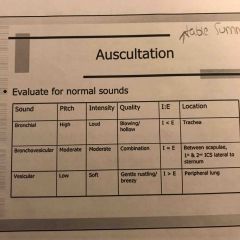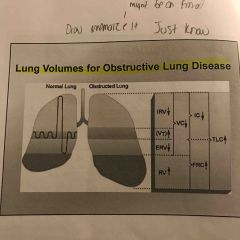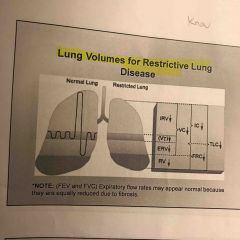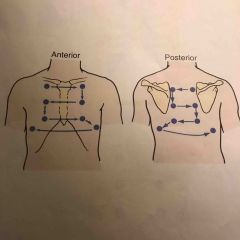![]()
![]()
![]()
Use LEFT and RIGHT arrow keys to navigate between flashcards;
Use UP and DOWN arrow keys to flip the card;
H to show hint;
A reads text to speech;
16 Cards in this Set
- Front
- Back
|
Respiratory physiology •The average total Lung capacity of an adult human male is about 6 liters (6000mL) |
Tidal breathing is normal, resting breathing Ventilation is the movement of air through the airways. Inhalation & exhalation. |
|
|
Lung Volume Tidal Volume (TV): The amount of air entering or leaving the lungs in a single normal, resting breath (500mL) Inspiratory Reserve Volume (IRV): The amount of extra air that can be forcibly inspired beyond the Tidal Volume (3000mL) makes / 2100mL females |
Expiratory Reserve Volume ( ERV): The amount of extra air that can be forcibly expired beyond tidal Volume. (1100mL males/ 800mL in females Residual Volume: The amount of air left in the lungs even after forcibly exhalation. (1200mL males/ 1000 mL females) |
|
|
Lung capacity Inspiratory Capacity (IC) : The maximum amount of air that can be taken in by the lungs (IC=Tidal Volume+Inspiratory Reserve Volume) (3500mL males / 2600mL in females) Functional Residual Capacity (FRC) The amount of air remaining in the lungs after a normal , resting exhalation (FRC=Residual Volume+Expiratory Reserve Volume) (2300mL males/ 1800mL females) |
Vital Capacity (VC): The maximum amount of air that can be expired after a maximum inspiration. VC= Inspiratory Reserve Volume + Expiratory Reserve Volume + Tidal Volume). (4600mL /3400mL) Total Lung Capacity (TLC) : The maximum amount of air the lungs can hold. TLC= Inspiratory Reserve Volume + Expiratory Reserve Volume + Tidal Volume + Residual Volume or Vital Capacity + Residual Volume (5800mL males/ 4300mL females
*TLC= IRV+ERV+ TV + RV RV= TLC-IRV-ERV-TV |
|
|
Normal breath sounds are divided into 3 different types: |
•Bronchial •Bronchovesicular •Vesicular |
|
|
Normal breath sounds: Bronchial |
Anterior Chest near 2nd & 3rd intercostal space; tubular & hallow-sounding; loud & high in pitch; sounds last longer than Inspiratory sounds |
|
|
Normal breath sounds: Bronchovesicular |
Posterior chest between scapulae & in the Center part of the anterior chest; softer than Bronchial sounds; tubular quality; equal during Inspiration & expiration; difference in pitch; intensity detected in expiration |
|
|
Normal breathing sounds: Vesicular |

Low soft, blowing or rustling sound; lung fields in the larger airways. Heard throughout inspiration, continue w/o pause through expiration & fade away about one third of the way through expiration |
|

*Obstructive is difficulty getting are out & Restrictive is difficulty getting air in, |

Back (Definition) |
|
|
Lungs are divided into lobes |
Right lung = 3lobes Left lung = 2lobes Phernic N C3,C4,C5 |
|
|
Test & measures |
Lab test: •Pulmonary Function Test (PFT) •Arterial Blood gas(ABG) Exercise test: Graded exercise test (also known as exercise tolerant test or (ETT) -using treadmill or stationary bike -6min walking test (MWT) |
|
|
Normal respiration rate for an adult is 12 to 20 BPM. Respiratory rate under 12 or over 25 bpm while resting is abnormal |
Hypoventilation: Slow, shallow breathing Causes CO2 to build up in the blood •Acidosis Hyperventilation: Rapid, deep breathing Causes CO2 to be blown off.•Alkalosis |
|
|
Lung Auscultation- listening over the chest wall during inspiration & expiration •tell pt to breath in & out slowly through the mouth |
Do not listen through gowns, cloths etc. place your stethoscope over bare skin |
|
|
Common types of Spirometer: Incentive spirometer- often use by pts who had surgery which might jeopardize respiratory function |
Peak flow meter- Measures a person’s maximum expiration, called either a peak Expiratory flow (PEP) or peak Expiratory Flow Rate(PEFR) |
|
|
Postural Draining: Indication: difficulty clearing airways secretions |
Precautions: related to the position needed to align the bronchus •Trendelenburg Position: Abdominal obesity, CHF,HTN, Nausea, Hiatal hernia, pulmonary edema, SOB w/ head lower. •Side- Lying Position: Vascular Surgery bypass graft, rib Fx, shoulder bursitis,etc |
|
|
Auscultations |

Back (Definition) |
|
|
K-Levels Medicare defines K-Levels based on an individuals potential functional ability. K0: Non- ambulatory & w/o potential to ambulate (no walking ability) K1: The patient has the ability or potential to use prosthesis for transfer or ambulation (walking) on level surface at a fixed cadence (speed). This is the typical level of the limited & unlimited house golf ambulator. |
K2: The pt has the ability or potential for ambulation (walking) on low level environmental barriers such as curbs, stairs, or uneven surfaces. This is typical of limited community ambulator. K3: The pt has the ability or potential for ambulation (walking) w/ variable cadence (speed). The is the typical level of the community ambulator who can traverse most environmental barriers & may have vocational, therapeutic or exercise beyond simple locomotion. K4: The pt has the ability or potential for ambulation (walking) the exceeds basic ambulation skills, exhibiting high impact stress or energy levels. This is the typical level prosthetic demands of the child, active adult, or athlete. |

